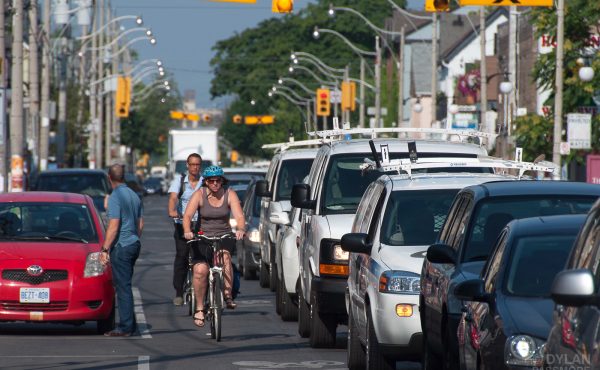
While I was away, a few people at the Toronto Star were following my Twitter and Facebook updates which contained snapshots of what I was experiencing in Copenhagen, especially from a cyclist’s perspective. I received an email asking if I’d look into Copenhagen’s approach to bike safety, which I had luckily already been doing.
Today, I have an article in the Star that looks at the helmet debate in the city. In Toronto, I’d never suggest to a cyclist not to wear a helmet since we lack the infrastructure that adequately protects riders from heavy traffic. But when you have a modal split like Copenhagen does (up to 40% bike, 30% drive, and 30% take transit), a helmet is less needed. And, as city officials argue, any kind of helmet bylaw would have a negative effect on Copenhagen’s bike ridership.
I happened to be in Copenhagen in early May when a video appeared on YouTube of a Danish police officer stopping a male cyclist, handing him a bike helmet and giving him a hug. Text scrolled across the screen that stated “We love you and would love you to wear a helmet.”
The viral film, produced by the Danish Cyclists Federation in the country’s fourth largest city of Aalborg, has put Copenhagen’s bike and traffic planners at odds with the federation.
“We don’t have a law in Copenhagen mandating cyclists to wear helmets,” says Brian Hansen, the head of the city’s traffic planning department. “We have no problem with anyone wearing a helmet and understand the safety benefits of it. But we’ve studied the topic many times and the results are always the same: it will decrease ridership significantly. We feel the health benefits of bike riding — active lifestyle, very low carbon emissions, clean air — far outweigh the risks of riding without a helmet.” And with ridership still increasing in the city, cycling is becoming even more safe. “The number of accidents has been decreasing year after year. More bikes on the road means it’s safer for cyclists,” says Hansen.
[youtube]http://www.youtube.com/watch?v=vWF4x01MkzE[/youtube]
This is the video I refer to in the Star article (above). What was even better was the response from Copenhagenize.com (below), a video that parodies the Danish Cyclists Federation’s approach.
[youtube]http://www.youtube.com/watch?v=YlaAt1p6Y5Q[/youtube]




4 comments
“The viral film, produced by the Danish Cyclists Federation in the country’s fourth largest city of Aalborg, has put Copenhagen’s bike and traffic planners at odds with the federation.”
Did I miss something? Why would ad produced by the cyclists federation promoting helmet use anger the copenhagen’s traffic planners? The traffic planners think that encouraging people to wear helmets (without a law) will decrease ridership?
Either the traffic planners are drunk, or you’ve misunderstood what’s happened in Denmark.
That’s exactly it, Confused. Read the article in the Star; bike planners try never to talk about bike safety since it makes people believe its unsafe (when studies show that more bikes mean more safety for riders).
It seems counter-intuitive to North Americans but enforcing riders to wear helmets drops ridership. The planners say they have no problem with people wearing them, but do not actively encourage it since it can drag their numbers down. read the quote again:
“We have no problem with anyone wearing a helmet and understand the safety benefits of it. But we’ve studied the topic many times and the results are always the same: it will decrease ridership significantly. We feel the health benefits of bike riding – active lifestyle, very low carbon emissions, clean air – far outweigh the risks of riding without a helmet.â€Â
The question of lack of helmets has little to do with infrastructure. It is a cultural and economic issue. There are 100 million daily cyclists in the EU accordingly to the European Cyclists Federation. Easily half don’t have dedicated infrastructure and yet they don’t wear helmets.
The reason is simple. The main helmet manufacturers are American and when they started suddenly promoting helmets in the late 1980’s, they targeted their local market and aimed helmets at those who cycled there; namely sports enthusiasts and hobby cyclists. The helmet was yet another piece of ‘necessary gear’. They capitalized on their branding of cycling as a fast-paced sport.
Ironically, no helmet manufacturer will tell you that helmets will or can save lives. This is simply because they are merely designed to protect the head from non-life threatening injuries in solo accidents under 20 km/h.
The helmet scepticism in Europe is due to thorough scientifc research on the subject. It can be summed up in the report issued by the European Council of Ministers of Transport [the ministers of transport for each EU nation] called National Policies to Promote Cycling (2004).
“PROMISING, a research project commissioned by the European Union and coordinated by the SWOV Institute for Road Safety Research (2001), suggests that from the point of view of restrictiveness, even the official promotion of helmets may have negative consequences for bicycle use, and that to prevent helmets having a negative effect on the use of bicycles, the best approach is to leave the promotion of helmet wear to manufacturers and shopkeepers.”
As a result the national cyclist federations in Holland, Germany, Belgium, Great Britain, Ireland, France, among other countries do NOT promote helmets and fight legislation tooth and nail.
The general attitude towards helmets in North America is the result of decades of exaggeration, misinformation, emotional blackmail all backed by the economic interests of the helmet industry.
if you can,t be bothered to make a film about copenhagen then is it really worth visiting.